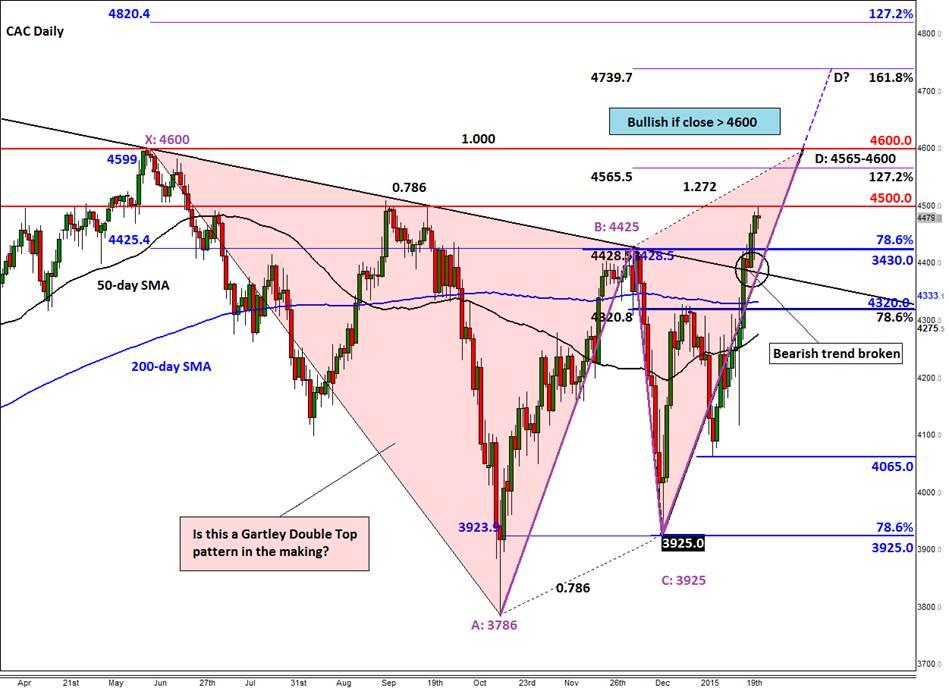![]()
The ECB day is finally here and the stock markets are relatively calm as investors await confirmation from the central bank itself. It could be the calm before the storm once the policy statement is released at 12:45 GMT and during the press conference at 13:30. Yesterday’s media reports suggested that the ECB is considering a quantitative easing programme of €50bn a month through to 2016. If true, this would thus be equivalent to €600 billion a year and up to €1.1 trillion until December 2016, depending on the starting date. It would also be significantly more than the previously-reported €500bn, which, if confirmed, could see the markets stage another sharp rally. That said, the market has priced in at least a €500bn stimulus programme, so anything less could lead to a correction of some sort (more on ECB HERE).
Greece worries could come back to forefront
Once the ECB is out of the way, the market’s focus is likely to shift to the Greek elections on Sunday. Although “Grexit†worries have been put to the back burner, they could come back to the forefront as early as Monday if the Greeks choose to elect the anti-austerity Syriza party into power. So, it could be that investors are underestimating the risks of Greece eventually exiting the euro zone. That said, the leader of Syriza has changed tack recently; instead of forcing his country to exit the Eurozone, he has instead promised to negotiate the terms of the bailout if he wins. Although the German’s have been vocal in their opposition for negotiation, the feeling in the market is that they may have to come to a compromise should Syriza win because the Eurozone is still better off with rather than without Greece. On top of this, it is widely believed that a vast majority of the European companies that were previously heavily exposed to Greece, have now reduced their exposure and are therefore better papered for its potential exit. Nevertheless, European banks such as France’s BNP Paribas, Credit Agricole and SocGen may still have some direct and indirect exposure to the troubled nation. This could potentially halt the CAC’s rally.
Technical outlook
The French benchmark CAC index has been technically-friendly of late. As can be seen on the chart, it has responded particularly well to the 78.6% Fibonacci retracement levels of the past three major price swings. This has helped us to identify a developing Fibonacci-based pattern: a Gartley Double Top, which also incorporates an AB=CD pattern. However, for the index to get to point D around 4665-4600, which is where this pattern suggests the market may top, it will have to break above resistance at 4500 which it is currently struggling to do so. Nevertheless, it has already taken out an 8-month old bearish trend line and old resistance at 3430, so the path of least resistance is to the upside. The old resistance at 3430 could turn into a near-term support level. Thus, should the index break below it at some stage in the very near term, a move down to the next support at 4320 could be on the cards. Meanwhile a potential break above 4600, which was the 2014 high, could pave the way for some significant gains in the coming weeks and months. In his case, the bulls’ initial targets could be the Fibonacci extension levels at 4740 (161.8% of BC) followed by 4820 (127.2% of XA).
Trading leveraged products such as FX, CFDs and Spread Bets carry a high level of risk which means you could lose your capital and is therefore not suitable for all investors. All of this website’s contents and information provided by Fawad Razaqzada elsewhere, such as on telegram and other social channels, including news, opinions, market analyses, trade ideas, trade signals or other information are solely provided as general market commentary and do not constitute a recommendation or investment advice. Please ensure you fully understand the risks involved by reading our disclaimer, terms and policies.
Recommended Content
Editors’ Picks
EUR/USD clings to gains above 1.0750 after US data

EUR/USD manages to hold in positive territory above 1.0750 despite retreating from the fresh multi-week high it set above 1.0800 earlier in the day. The US Dollar struggles to find demand following the weaker-than-expected NFP data.
GBP/USD declines below 1.2550 following NFP-inspired upsurge

GBP/USD struggles to preserve its bullish momentum and trades below 1.2550 in the American session. Earlier in the day, the disappointing April jobs report from the US triggered a USD selloff and allowed the pair to reach multi-week highs above 1.2600.
Gold struggles to hold above $2,300 despite falling US yields

Gold stays on the back foot below $2,300 in the American session on Friday. The benchmark 10-year US Treasury bond yield stays in negative territory below 4.6% after weak US data but the improving risk mood doesn't allow XAU/USD to gain traction.
Bitcoin Weekly Forecast: Should you buy BTC here? Premium

Bitcoin (BTC) price shows signs of a potential reversal but lacks confirmation, which has divided the investor community into two – those who are buying the dips and those who are expecting a further correction.
Week ahead – BoE and RBA decisions headline a calm week

Bank of England meets on Thursday, unlikely to signal rate cuts. Reserve Bank of Australia could maintain a higher-for-longer stance. Elsewhere, Bank of Japan releases summary of opinions.
